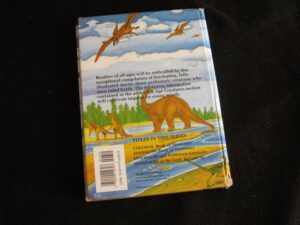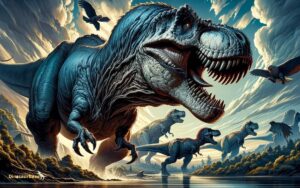When Dinosaurs Were Discovered? Unearth History Now!
As dawn broke over the horizon of human knowledge, the discovery of dinosaurs awakened a curiosity as ancient as the creatures themselves. Scholars and adventurers alike stumbled upon these titanic relics, buried for eons, revealing a past world’s secrets.
Mary Anning’s keen eye and the sharp minds of those who coined the term ‘dinosaur’ laid the foundation for a field that would captivate humanity’s imagination. However, the tale of discovery is far from complete, with layers of history and science still veiled in mystery.
Unearthing these stories promises to illuminate not only the Earth’s prehistoric life but also the evolution of scientific thought.


Key Takeaway
The Pre-Discovery Era
Long before the formal discovery of dinosaurs, myriad cultures around the world had stumbled upon and interpreted the fossilized remains of these colossal creatures through the lens of myth and legend.
Ancient civilizations didn’t recognize these remnants as belonging to animals that had preceded them by millions of years. Instead, they often attributed such findings to dragons, giants, or other mythological beings, integrating them into their folklore and spiritual narratives.
This conceptual framework reflects an attempt to make sense of the natural world, applying the knowledge and cultural context available at the time.
Scholars suggest that these interpretations, while not scientifically accurate, highlight the human inclination towards curiosity and storytelling, serving as a precursor to the systematic study of paleontology.
This era, thus, marks a pivotal, albeit nascent, phase in humanity’s understanding of Earth’s ancient inhabitants.
Early Fossil Discoveries
Unearthing the first dinosaur fossils marked a transformative moment in scientific history, as researchers began piecing together the existence of these ancient giants with evidence rather than myth.
This pivotal period saw several significant developments:
- Identification of Distinct Species: Early fossil discoveries enabled scientists to categorize dinosaurs into distinct species, providing a foundational taxonomy.
- Understanding of Extinction Events: Fossils offered the first concrete evidence of mass extinction events, challenging previous notions of a static, unchanging Earth.
- Reconstruction of Prehistoric Ecosystems: By examining fossilized remains, researchers reconstructed the ecosystems these creatures inhabited, offering insights into climate, flora, and fauna of ancient times.
These early findings laid the groundwork for paleontology, transforming it from speculative storytelling into a rigorous scientific discipline.
Mary Anning’s Contributions
Mary Anning’s contributions to the field of paleontology profoundly altered our understanding of prehistoric life. Her meticulous fossil discoveries, notably in the Lyme Regis area, provided critical evidence for the existence of previously unknown dinosaur species.
Anning’s legacy extends beyond her finds, influencing the methodologies and ethical standards of modern paleontological research.
Anning’s Fossil Discoveries
Despite facing significant societal barriers in early 19th-century England, Mary Anning’s meticulous fossil discoveries significantly advanced the field of paleontology.
Anning’s contributions weren’t merely accidental findings; they were the result of her keen observational skills and persistence in the challenging cliffs of Lyme Regis.
Her major discoveries include:
- The first correctly identified ichthyosaur skeleton, which reshaped scientific understanding of prehistoric marine life.
- The first two plesiosaur skeletons, unveiling creatures with long necks that defied contemporary scientific expectations.
- Important fossil finds of pterosaurs outside Germany, contributing to the knowledge of aerial reptiles.
These discoveries challenged existing perceptions about the history of life on Earth and laid foundational stones for the development of paleontology as a scientific discipline.
Legacy in Paleontology
Anning’s groundbreaking fossil discoveries have left an indelible mark on the field of paleontology, fundamentally altering scientific perspectives on prehistoric life and its evolution.
Her meticulous work not only expanded the fossil record but also challenged the existing paradigms of her time.
Anning’s identification of the first ichthyosaur skeleton, alongside discoveries of plesiosaurs and important fish fossils, provided empirical evidence that supported the then-nascent theory of extinction.
Her contributions underscored the dynamic nature of Earth’s biological history, paving the way for the development of evolutionary biology.
Her legacy persists in the scientific method applied in paleontology, emphasizing detailed observation and the critical analysis of evidence.
Anning’s work exemplifies how individual contributions can significantly advance scientific understanding, setting a precedent for future generations of paleontologists.
The Term “Dinosaur” Coined
In 1842, Sir Richard Owen introduced the term ‘dinosaur,’ marking a significant milestone in the field of paleontology by categorizing these extinct giants under a single name for the first time.
This act of nomenclature wasn’t merely administrative; it encapsulated several pivotal ideas:
- Unity in Diversity: Owen recognized that these creatures, despite their varied forms, shared distinctive anatomical traits.
- Conceptual Framework: The term provided a foundational category for future discoveries, enabling a systematic approach to the study of prehistoric life.
- Scientific Communication: It facilitated clearer, more effective discourse among scientists, enhancing collaboration and understanding across the globe.
Owen’s insight laid the groundwork for paleontology as a cohesive scientific discipline, underscoring the importance of terminology in the categorization and comprehension of natural history.
The Great Bone Wars
Following the establishment of dinosaurs as a distinct category by Sir Richard Owen, the field of paleontology witnessed the onset of the Great Bone Wars, a fierce competition between rival scientists that significantly advanced our understanding of these ancient creatures.
| Aspect | Edward Drinker Cope | Othniel Charles Marsh |
|---|---|---|
| Discoveries | Over 1,000 species | 500+ species |
| Approach | Rapid, less precise | Methodical, detailed |
| Impact | Expanded knowledge, introduced errors | Standardized paleontological methods |
This rivalry, marked by both profound discoveries and bitter disputes, propelled the science of paleontology forward, laying the groundwork for future generations.
The competition’s intensity drove both men to extremes, but it undeniably contributed to the rapid expansion of our dinosaur fossil record, enriching the scientific community’s understanding of prehistoric life.
Expanding the Dinosaur Family
As the Great Bone Wars concluded, the scientific community’s focus shifted towards broadening the taxonomic classification and understanding of the dinosaur family, a task that demanded rigorous analysis and innovative methodologies.
Researchers embarked on a mission to refine and expand the dinosaur family tree by employing:
- Comparative anatomy to identify shared characteristics among different species.
- Paleobiogeography to understand the distribution and migration patterns of dinosaurs across ancient landmasses.
- Cladistics to reconstruct evolutionary relationships based on shared derived traits.
This meticulous approach allowed scientists to classify dinosaurs into more precise groups, shedding light on their diversity and evolutionary history.
The expansion of the dinosaur family through these methods provided a foundation for future paleontological discoveries, setting the stage for an era of unprecedented insight into the Mesozoic era.
The 20th Century Finds
The 20th century witnessed a remarkable surge in dinosaur discoveries, significantly enriching our understanding of these ancient creatures through the unearthing of numerous new species.
This period was marked by the identification of previously unknown dinosaur genera, which provided crucial insights into their diversity and evolution.
| Year Discovered | Dinosaur Species |
|---|---|
| 1902 | Tyrannosaurus Rex |
| 1914 | Brachiosaurus |
| 1923 | Velociraptor |
| 1942 | Triceratops |
| 1999 | Giganotosaurus |
These discoveries, spread across the century, showcased the wide range of sizes, habits, and environments these creatures occupied. Each find added a piece to the puzzle of Earth’s prehistoric past, challenging previous assumptions and opening new avenues for research.
The 20th century’s paleontological achievements laid a solid foundation for future explorations, setting the stage for even more sophisticated methodologies and groundbreaking discoveries.
Revolutionary Techniques
The advent of radiometric dating breakthroughs has markedly enhanced the precision with which scientists can determine the age of dinosaur fossils, offering a transformative lens through which the timeline of dinosaur evolution is viewed.
Concurrently, CT scanning insights have allowed researchers to peer into the very structure of dinosaur bones without causing damage, revealing intricate details about their anatomy, pathology, and evolutionary adaptations.
These revolutionary techniques have collectively propelled the field of paleontology into a new era of discovery, providing unprecedented accuracy and depth in the study of dinosaurs.
Radiometric Dating Breakthroughs
Recent advancements in radiometric dating techniques have significantly refined our understanding of dinosaur fossils’ ages, offering more precise temporal frameworks for their study. These breakthroughs are pivotal in the accurate reconstruction of the dinosaurs’ timeline and their environment.
The key developments include:
- Laser Ablation Inductively Coupled Plasma Mass Spectrometry (LA-ICP-MS): This allows precise dating of minute fossil samples, reducing the need for large samples.
- Uranium-Lead (U-Pb) Dating: This technique has improved the accuracy of dates for dinosaur bones by pinpointing the age of surrounding sedimentary layers.
- Argon-Argon (Ar-Ar) Dating: Enhancements here have facilitated more accurate dating of volcanic ash layers that intersect dinosaur fossil strata, offering clearer time markers.
These methods have collectively enhanced the chronological precision in paleontology, deepening our understanding of the mesozoic era and the life forms it harbored.
CT Scanning Insights
Building on the advancements in radiometric dating, CT scanning technology has emerged as a pivotal tool in uncovering the intricate details of dinosaur fossils, offering unprecedented insights into their anatomy and evolution.
This non-invasive method allows researchers to peer inside fossilized remains without damaging them, revealing minute structures that were previously invisible.
By generating high-resolution three-dimensional images, CT scans provide a detailed view of the internal morphology of dinosaur bones, including the texture of bone tissues, growth patterns, and even remnants of soft tissues in some cases.
These insights have revolutionized our understanding of dinosaur physiology, feeding habits, and developmental processes, contributing significantly to the field of paleontology.
As CT scanning technology continues to evolve, it promises to unveil even more about these ancient creatures, deepening our knowledge of their place in the Earth’s history.
The Role of Paleobiology
Paleobiology plays a critical role in unraveling the intricate history of dinosaurs, providing insights into their evolutionary processes, behaviors, and ecological impacts. This scientific discipline merges principles of biology with the fossil record to offer a detailed glimpse into the past.
Key contributions include:
- Reconstruction of Ecosystems: Paleobiologists piece together ancient habitats, revealing how dinosaurs interacted with their environment and other species.
- Understanding Dietary Habits: Analysis of tooth wear patterns and stomach contents helps determine what dinosaurs ate, shedding light on food chains and ecological roles.
- Deciphering Growth Patterns: By studying bone histology, researchers can infer growth rates and life stages, offering clues about dinosaur lifespan and reproductive strategies.
These insights not only enrich our understanding of dinosaur biology but also illuminate broader evolutionary narratives across geological time.
Recent Discoveries
While the role of paleobiology has significantly advanced our understanding of dinosaur ecology and evolution, ongoing research and discoveries continue to reshape our perspectives on these prehistoric creatures.
Recent findings haven’t only unearthed new species but also provided insights into their behaviors, diets, and environments.
For instance, the discovery of well-preserved feathers on certain dinosaur fossils has irrevocably altered the perception of their appearance and has bolstered the theory of a direct evolutionary link to modern birds.
Moreover, advancements in technology, particularly in imaging and molecular analysis, have enabled scientists to examine fossils at a molecular level, revealing details about growth patterns, diseases, and even colors.
These breakthroughs underscore the dynamic nature of paleontological research, where each discovery potentially revises or enriches our understanding of the Mesozoic era.
Conclusion
The quest for understanding dinosaurs has been a journey akin to peeling an enormous, complex onion, layer by intricate layer.
From the serendipitous pre-discovery era to the groundbreaking advances of the 21st century, each phase has significantly deepened our comprehension.
The advent of revolutionary techniques and the integration of paleobiology have catalyzed this knowledge explosion.
Recent discoveries continue to refine our perspectives, proving that our grasp of these ancient beings is still evolving, detailed and nuanced, like the creatures themselves.




